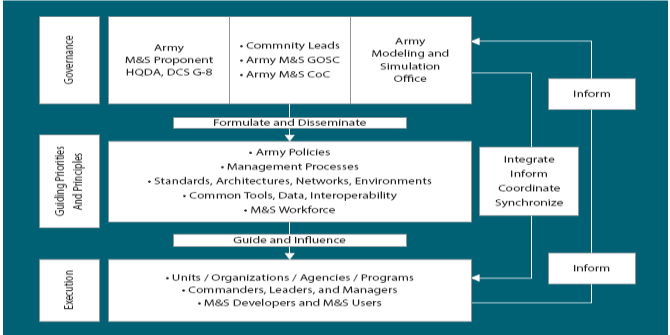Modeling and Simulation (M&S) capabilities enhance the ability of the Department of Defense to meet strategic and operational challenges in a complex and fiscally constrained environment. The Army recognized the importance of M&S and developed a robust framework and governance structure to provide technology and capabilities to leaders and soldiers. The Chief of Staff of the Army and the Secretary of the Army signed the Army M&S Strategy in July 2014. The Strategy defines the Army’s M&S vision and goals, underscored by strong management and governance processes and practices. As part of the Strategy, the Army’s M&S Governance structure is currently evaluating priorities and gaining insights to guide implementation.
The Army’s M&S Enterprise is composed of six communities that actively use M&S in their processes and activities. The six communities are: Acquisition, Analysis, Experimentation, Intelligence, Test and Evaluation, and Training. It addresses over 30 Programs of Record with resources directly identifiable in the Army Program Objective Memorandum (POM). Additionally, the Army M&S activities include hundreds of technology tools and resources embedded in over 100 Program Elements. While the Army Communities own their resources and requirements, the Army M&S Governance structure informs and synchronizes cross-community, intra-community, and cross-Defense issues (Figure 1).
Additionally, the Army updated their regulation on M&S Management, AR 5-11 on 30 May 2014. In the update, the regulation prescribes appointment of general officer or senior executive service lead for each of the six M&S communities. This advocacy, together with the governance structure outlined, has set up the management to execute the Vision and Goals of the Strategy.
One of the current efforts using the Army’s M&S Governance Structure is the Live Synthetic Enterprise Architecture (LSEA). This endeavor is one example of how, through a governance process, M&S can provide capabilities to many communities in an integrated shared approach. The LSEA, with active participation from the Army Modeling & Simulation Office, Army Operational Test Command, and the Program Executive Office for Simulation, Training, and Instrumentation addresses the requirements for interoperability, reuse, adaptability, and net-centric data exchange for effective synchronization of acquisition efforts across the Army. The LSEA conceptual framework evaluated common interests with an opportunity to inform efficiencies. These include Live-Synthetic M&S capabilities, Service-Oriented Architecture, Mission Command System M&S interface, interoperability, Common Operating Environment compliance, and geospatial information.
In the past year, the M&S Governance bodies have been actively involved in cross-Army efforts on the Live-Synthetic Training and Test and Evaluation (LSTTE) Enterprise Architecture proof of concept to the LSEA. The LSTTE-Enterprise Architecture is developing the reference architecture, business model, and governance structure necessary to enable sharing of common services and capabilities via service-oriented-architecture. It is essential for building interoperability and common operating environment compliance into material solutions of the future.


